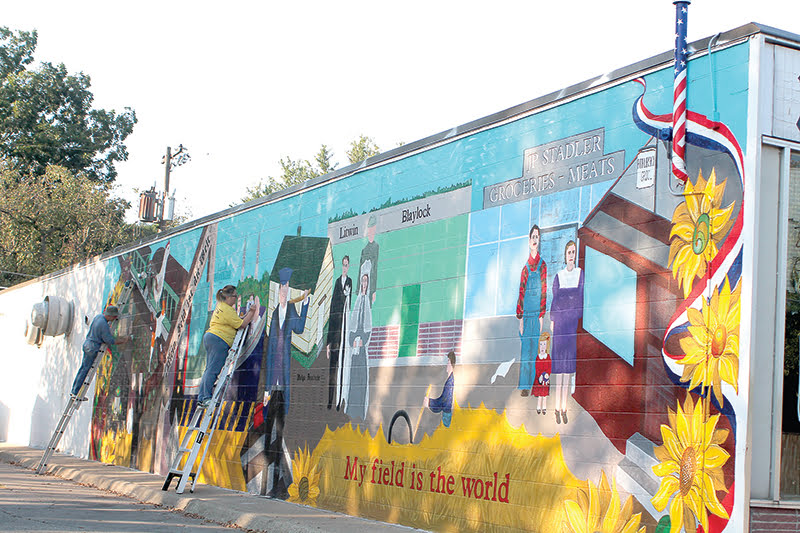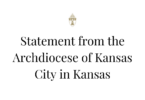
Dave Rose places some finishing touches on the mural on Sept. 27. Married to lead artist Dale Rose, Dave has been assisting on a regular basis by doing some of “the high work” and carrying supplies to and from the site. The mural, titled “My Field is the World,” is painted on the side of Pizza Parlor in Topeka’s Oakland neighborhood. The mural pays tribute to the German-Russians who settled the area in the late 1800s.
by Marc and Julie Anderson
mjanderson@theleaven.org
TOPEKA — There was a time when the graffiti-scarred eastern wall of the Pizza Parlor restaurant in the Oakland neighborhood here looked altogether grim.
Now, thanks to lead artist Dale Rose and a number of volunteers, the wall is a colorful tribute to local history that is only a little “Grimm.”
Beginning this summer, Rose and her group of community artists transformed the restaurant wall into the “German Descent Mural,” a tribute to the Volga- Germans who came to Topeka during the mid-1870s to ’80s and founded St. Joseph and Sacred Heart parishes.
Father Tim Haberkorn, pastor of the now unified Sacred Heart-St. Joseph Parish and a descendant of Volga-German immigrants, blessed the mural on Oct. 5.
The mural is full of symbolism, according to Rose, a member of St. Matthew Parish in Topeka.
The mural pictures a wide range of images: from a classic onion-domed Russian Orthodox church to a ship representing the immigrants’ voyage across the Atlantic to America to a wheat field with the phrase in German “Mein Feld ist die Welt,” which translates in English to “My field is the world,” echoing the scriptural reference to the world as Christ’s vineyard.
The St. Joseph Church twin steeples with the clocks at “10:05” — the date of the blessing and dedication — are also in the mural, as are a wedding scene; the names of German-founded businesses, and something Grimm.
That’s Grimm as in the Brothers Grimm, famous writers of German folktales. The mural depicts the farm animals from their story “The Town Musicians of Bremen.”And here’s how that got into the mix.
The Volga-Germans were descendants of Germans (and some others) who were recruited by agents of Czarina Catherine the Great of Russia in the 1760s to resettle depopulated areas along the Volga River near Saratov.
By the 1870s, things weren’t so good in Russia, and railroad representatives enticed the disaffected ethnic Germans to come to America. According to local legend, the emigrants encountered the sculpture recalling “The Town Musicians of Bremen” at the Bremen train station.
The sculpture, which recalled a story about mistreated animals that left their homes to start anew in a place of freedom, resonated with the Volga-Germans and they adopted the story as an allegory for their own lives.
Some families went further west and some ended up in Topeka, where they founded St. Joseph Parish in downtown and Sacred Heart in the Oakland neighborhood.
Although the neighborhood is now mostly known for its large population of Hispanics, it was a Hispanic woman who reminded the North Topeka Arts Organization mural planning team to not forget the other major ethnic group that settled the area — the Volga-Germans. So the mural contains the names of nearly 100 Volga-German settler family names.
“The younger generations don’t know the story of their ancestors,” said Bill Domme, who co-owns the restaurant with his wife Joanne. “[The mural] is a way of educating them about their heritage. To the older people, [the mural] is a way of honoring their ancestors.”
“I never forget each day that I am a Volga-German,” continued Domme. “When people ask me who I am, I always say first I am a Volga-German.”






